Every year, the NASA Innovative Advanced Concepts (NIAC) program puts out the call to the general public, hoping to find better or entirely new aerospace architectures, systems, or mission ideas. As part of the Space Technology Mission Directorate, this program has been in operation since 1998, serving as a high-level entry point to entrepreneurs, innovators and researchers who want to contribute to human space exploration.
This year, thirteen concepts were chosen for Phase I of the NIAC program, ranging from reprogrammed microorganisms for Mars, a two-dimensional spacecraft that could de-orbit space debris, an analog rover for extreme environments, a robot that turn asteroids into spacecraft, and a next-generation exoplanet hunter. These proposals were awarded $100,000 each for a nine month period to assess the feasibility of their concept.
Of the thirteen proposals, four came from NASA’s own Jet Propulsion Laboratory, with the remainder coming either from other NASA bodies, private research institutions, universities and aerospace companies from around the country. Taken as a whole, these ideas serve to illustrate of the kinds of missions NASA intends to purse in the coming years, as well as the cutting-edge technology they hope to leverage to make them happen.
“The NASA Innovative Advanced Concepts (NIAC) program is one of NASA’s early stage technology development programs. At NIAC, we concentrate on mission studies that demonstrate the benefit of new technologies that are on the very edge of science fiction, but while still remaining firmly rooted in science fact.”
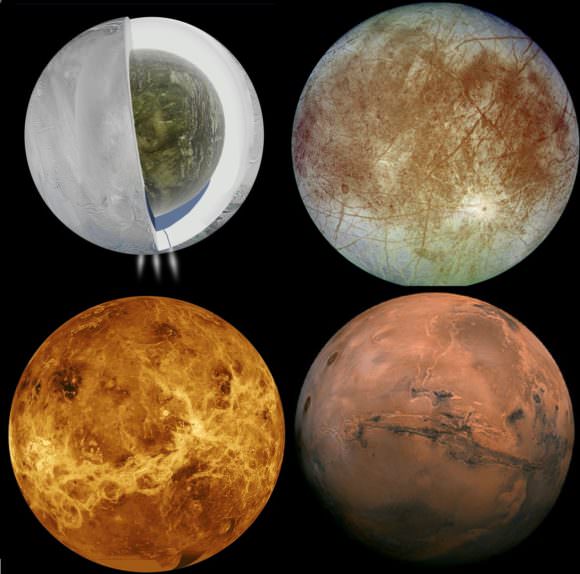
Those proposals that are deemed feasible will be eligible to apply for a Phase II award, which consists of up to $500,000 of additional funding and two more years of concept development. And as with previous years, those concepts that were selected for Phase I were highly representative of NASA’s research and exploration goals, which include missions beyond Low-Earth Orbit (LEO) to near-Earth asteroids, Mars, Venus, and the outer Solar System.
“All 13 of these new NIAC studies are innovative, interesting, and groundbreaking in their own fields,” said Derleth. “There are a mix of NASA researchers, universities, and industry-led studies, all chosen by a process meant to identify and fund the ones with the most impact to our efforts to push the envelope in aerospace technology.”
For example, the Jet Propulsion Laboratory’s submissions included a mission that would send a probe back to Venus to explore its atmosphere in greater depth. Known as the Venus Interior Probe Using In-situ Power and Propulsion (VIP-INSPR), this small solar-powered craft would use hydrogen harvested from Venus’ atmosphere – which would be isolated through electrolysis – for altitude control at high altitudes (in a balloon), and as a back-up power source at lower altitudes.
Within Venus’ atmosphere, solar power is no longer a viable option (due to low solar intensity) and primary batteries tend to survive for only an hour or two. What’s more, radioisotope thermoelectric generators (RTGs) – like those that powered the Voyager missions – were dismissed as inefficient for the purposes of a Venus probe.
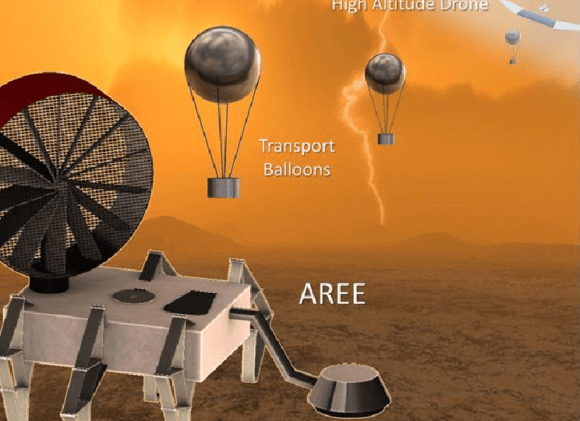
VIP-INSPR will address these problems by refilling hydrogen on one end of its structure and providing power on the other, thus enabling sustained exploration of the Venusian atmosphere. This is a creative solution to addressing the challenge of keeping a probe powered as it enters Venus’ thick atmosphere, and is sure to have applications beyond the exploration of just Venus.
Similarly, another concept from the JPL involves sending a next-generation rover to Venus, known as the Automaton Rover for Extreme Environments (AREE). This rover seeks to build on the accomplishments of the Soviet Venera and Vega programs, which were the only missions to ever successfully land rovers on Venus’ hostile surface.
Unfortunately, those probes that successfully landed only survived for 23 to 127 minutes before their electronics failed and they could no longer send back information. But by using an entirely mechanical design and a hardened metal structure, the AREE could survive for weeks or months, long enough to collect and return valuable long-term scientific data.
In essence, they proposed reverting back to an ancient concept, using analog gears instead of electronics to enable exploration of the most extreme environment within the Solar System. Beyond Venus, such a probe would also be useful in such hostile environments as Mercury, Jupiter’s radiation belt, and the interior of gas giants, within volcanoes, and perhaps even the mantle of Earth.
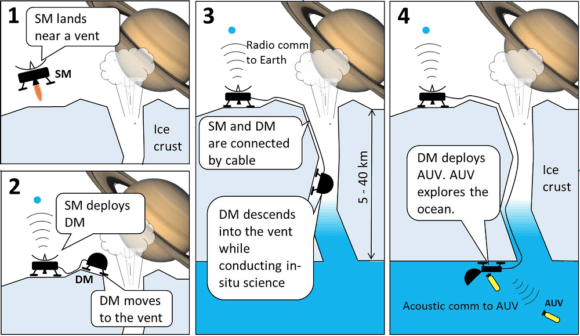
Then there is the Icy-moon Cryovolcano Explorer (ICE), another JPL submission which, it is hoped, will one-day explore icy, volcanically-active environments like Europa and Enceladus. The concept of an autonomous underwater vehicle (AUV) is something that has been explored a lot in recent years, but the task of getting such a vehicle to Jupiter or Saturn and beneath the surface of one of their moons presents many challenges.
The ICE team addresses these by designing a surface-to-subsurface robotic system that consists of three modules. The first is the Surface Module (SM), which will remain on the surface after the craft has landed, providing power and communications with Earth. Meanwhile, the Descent Module (DM) will use a combination of roving, climbing, rappelling and hopping to descend into a volcanic vent. Once it reaches the subsurface ocean, it will launch the AUV module, which will explore the subsurface ocean environment and seek out any signs of life.
Last, but not least, the JPL also proposed the Electostatic-Glider (E-Glider) for this year’s NIAC program. This proposal calls for the creation of an active, electrostatically-powered spacecraft to explore airless bodies. Basically, near the surface of comets, asteroids and the Moon, the environment is both airless and full of electrically-charged dust, due to the Sun’s photoelectric bombardment.
A glider equipped with a pair of thin, charged appendages could therefore use the interactions with these particles to create electrostatic lift and propel itself around the body. These appendages are also articulated to direct the levitation force in the whatever direction is most convenient for propulsion and maneuvering. It would also be able to land by simply retracing these appendages (or possibly using thrusters or an anchor).
Beyond NASA, other concepts that made the cut include the Tension Adjustable Novel Deployable Entry Mechanism (TANDEM). In a novel approach, the TANDEM consists of a tensegrity frame with a semi-rigid deployable heat shield composed of 3-D woven carbon-cloth. The same infrastructure is used for every part of the mission, with the shield providing protection during entry, and the frame providing locomotion on the surface.
By reusing the same infrastructure, TANDEM seeks to be the most efficient system ever proposed. The use of tensegrity robotics, which is a largely unexplored concept at present, also provides numerous potential benefits during entry and descent. These include the ability to adjust its shape to achieve an optimal landing, and the ability to reorient itself and charge its aerodynamic center if it gets overturned.
What’s more, conventional tensegrity locomotion depends largely on the actuation of outer cables, which requires mechanical devices in each strut to reel in the cables. However, such a system can prove impractical when used in extreme environments, since it requires that each strut be protected from the environment. This can make the vehicle overly-heavy and contribute to higher launch costs.
The TANDEM, in contrast, relies on only inner cable actuation, which allows the locomotion mechanisms to be housed in the central payload module. Taken together, this means that the TANDEM concept can allow for landings in new locations (opening up the possibility for new missions), can traverse significantly rougher terrain than existing rovers, and provide a higher level of reliability, safety and cost-effectiveness to surface missions.
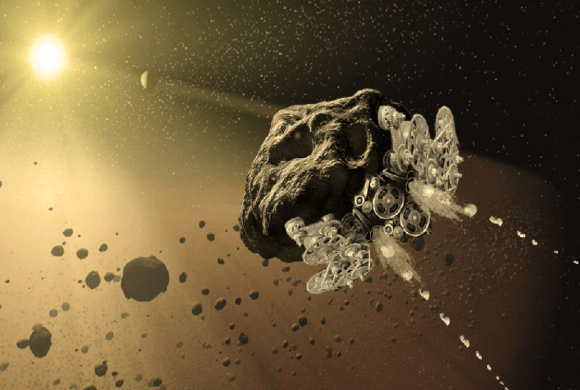
From the private sector, Made In Space was awarded a Phase I grant for their concept of Reconstituting Asteroids into Mechanical Automata (RAMA). In brief, this concept boils down to using analog computers and mechanisms to convert asteroids into enormous, autonomous mechanical spacecraft, which is likely to have applications when it comes to diverting Potentially-Hazardous Asteroids (PHAs) from Earth, or bringing NEOs closer to Earth to be studied.
The concept was designed with recent developments in additive manufacturing (3-D printing) and in-situ resource utilization (ISRU) in mind. The mission would consist of a series of technically simple robotic components being sent to an asteroid, which would then convert elements of it into very basic parts of spacecraft subsystems – such as guidance, navigation and control (GNC) systems, propulsion, and avionics.
Such a proposal offers cost-saving measures since it eliminates the need to launch all spacecraft subsystems into space. It also offers an affordable and scalable way for NASA to realize future mission concepts, such as the Asteroid Redirect Mission (ARM), the New Frontiers Comet Surface Sample Return, and other Near Earth Object (NEO) applications. If all goes according to plan, Made In Space believes that it will be able to create a space mission that utilizes 3-D printing and ISRU within 20 to 30 years.
Another interesting concept is the Direct Fusion Drive (DFD), which was proposed by Princeton Satellite Systems Inc. Based on the Princeton Field-Reversed Configuration (PFRC) fusion reactor, which is under development at the Princeton Plasma Physics Laboratory, this mission would involve sending a 1000 kg lander to Pluto within 4 to 6 years. By comparison, the New Horizons space probe took roughly 9 years to reach Pluto and didn’t have the necessary fuel to slow down or make a landing.
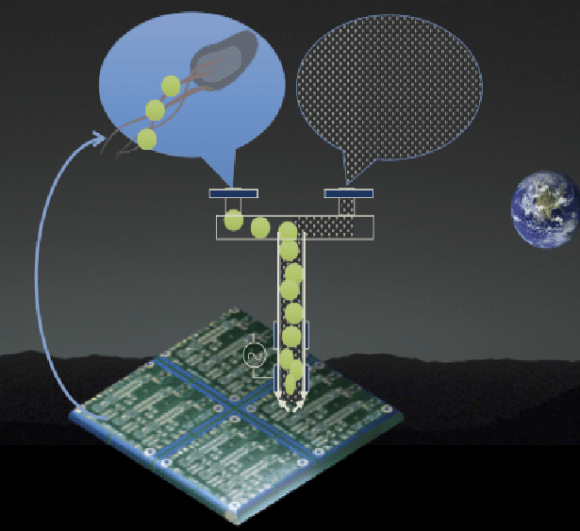
NASA’s Ames Research Center also proposed a mission that would rely on bioprinting and an end-to-end recycling system to turn Mars’ own atmosphere into replacement electronics. Under the guidance of Dr. Lynn Rothschild, this revolutionary idea calls for small living cells to be printed out in a gel which will then consume resources (like the local atmosphere) and excrete metals, or plastics, or other useful materials.
With this kind of technology, the mass of missions could be significantly reduced, and replacement electronics could be created on-site to address failures or breakdowns. This proposal will not only enhance the likelihood of mission success, but could also have immediate applications to environmental issues here on Earth (not the least of which is the problem of e-waste).
The other winning proposals can be read about here, and include a probe that will analyze the molecular composition of “cold targets” in the Solar System (such as asteroids, comets, planets and moons), a 2-dimensional brane craft that could merge with orbital debris to deorbit it, and the Nano Icy Moons Propellant Harvester (NIMPH) – a proposed Europa mission that would involve Cubesat-sized microlanders harvesting water from the moon’s interior ocean.
There is also the NASA Kennedy Space Center’s Mars Molniya Orbit Atmospheric Resource Mining craft, which would use resources in Mars orbit to make travel to the Red Planet more affordable for future missions. And last, but not least, there was the exoplanet-hunter proposed by Nanohmics Inc., which would use a technique known as stellar echo imaging to provide more detailed imaging of exoplanets than existing techniques.
All in all, this year’s Phase I awards represent a good smattering of the research goals NASA intends to pursue in the coming years. These include, bu are not limited to, studying NEOs, returning to Venus, more missions to Mars and Pluto, and exploring the exotic environments of the outer Solar System. Only time will tell which missions will move from science fiction into the realm of science fact, and which ones will have to be put aside for later consideration.
Further Reading: NASA, NIAC 2016 Phase I Selections

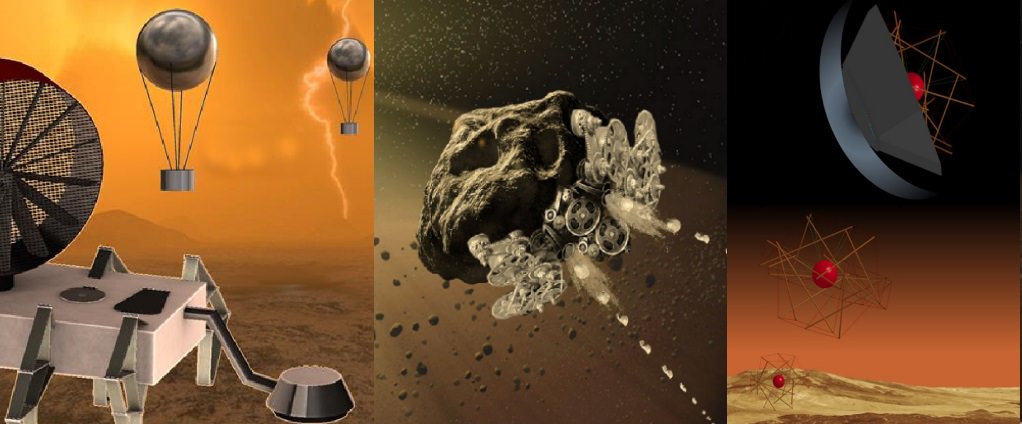
wow…